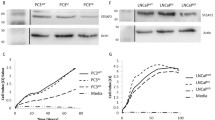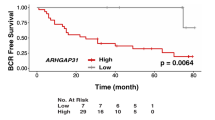Abstract
To identify Dishevelled-2 (Dvl2) is a prostate cancer-associated gene and analyze the effects on the growth and invasive capacity of human prostate cancer (PCa) cells. Dvl2 mRNA expression was measured in PCa cell lines and tissue samples, by real-time reverse transcription PCR (qRT-PCR). Immunohistochemistry was used to examine the distribution of Dvl2 in PCa specimens. Silencing Dvl2 in LNCaP cells, proliferation was measured by the CCK-8 assay, cell motility and invasiveness by scratch wound and transwell migration assays, and Wnt-3a, AR, and matrix metalloproteinase (MMP) expression by western blotting. Dvl2 was overexpressed in LNCaP cells compared with the AI PCa lines DU-145 and PC-3, as well as in the majority of PCa tissue specimens examined by qRT-PCR (14/27, 51.9 %). Dvl2 expression was low in all 10 BPH specimens, weakly positive in 26/104 AD PCa specimens (23.8 %), positive in 60/104 AD PCa specimens (55 %), and strongly positive in all 5 AI PCa specimens. Dvl2 expression was significantly correlated with combined Gleason score (p = 0.02), lymph node metastasis (p = 0.005), and TNM stage (p = 0.015). Silencing of Dvl2 mRNA expression significantly reduced LNCaP cell proliferation, motility, invasiveness and Wnt-3a, AR, MMP-2, and MMP-9 expression. Dvl2 may increase PCa growth and metastasis potential, possibly by upregulating Wnt-3a, AR, and MMP expression. Silencing Dvl2 expression may be an effective treatment strategy for PCa.







Similar content being viewed by others
References
Jemal A, Siegel R, Ward E et al (2009) Cancer stastistics. CA Cancer J Clin 59:225–249
Feldman BJ, Feldman D (2001) The development of androgen-independent prostate cancer. Nat Rev Cancer 1:34–35
Emami KH, Corey E (2007) When prostate cancer meets bone: control by Wnts. Cancer Lett 253:170–179
Paul S, Dey A (2008) Wnt signaling and cancer development: therapeutic implication. Neoplasma 55:165–176
Wallingford JB, Habas R (2005) The developmental biology of Dishevelled: an enigmatic protein governing cell fate and cell polarity. Development 132:4421–4436
Uematsu K, He B, You L et al (2003) Activation of the Wnt pathway in non small cell lung cancer: evidence of disheveled overexpression. Oncogene 22:7218–7221
Uematsu K, Kanazawa S, You L et al (2003) Wnt pathway activation in mesothelioma: evidence of Dishevelled overexpression and transcriptional activity of β-catenin. Cancer Res 63:4547–4551
Mizutani K, Miyamoto S, Nagahata T et al (2005) Upregulation and overexpression of Dvl1, the human counterpart of the Drosophila Dishevelled gene, in prostate cancer. Tumor 91:546–551
Zhao Y, Yang Z, Wang Y et al (2010) Dishevelled-1 and Dishevelled-3 affect cell invasion mainly through canonical and noncanonical Wnt pathway, respectively, and associate with poor prognosis in nonsmall cell lung cancer. Mol Carcinog 49:760–770
Yee DS, Tang Y, Li X et al (2010) The Wnt inhibitory factor 1 restoration in prostate cancer cells was associated with reduced tumor growth, decreased capacity of cell migration and invasion and a reversal of epithelial to mesenchymal transition. Mol Cancer 9:162–175
Wang Q, Diao X, Sun J et al. (2011) Regulation of VEGF, and metastasis by CXCR4 in a prostate cancer cell line. Cell Biol Int. as manuscript CBI20100744
Horoszewicz JS, Leong SS, Chu TM et al (1980) The LNCaP cell line-a new model for studies on human prostatic carcinoma. Prog Clin Biol Res 37:115–132
Tso CL, McBride WH, Sun J et al (2000) Androgen deprivation induces selective outgrowth of aggressive hormonerefractory prostate cancer clones expressing distinct cellular and molecular properties not present in parental androgen-dependent cancer cells. Cancer J 6:220–233
Schweizer L, Rizzo CA, Spires TE, Gottardis MM, Attar RM et al. (2008) The androgen receptor can signal through Wnt/beta-catenin in prostate cancer cells as an adaptation mechanism to castration levels of androgens. BMC Cell Biol. 9:4. doi:10.1186/1471-2121-9-4
Tada M, Smith JC (2000) Xwnt11 is a target of Xenopus Brachyury: regulation of gastrulation movements via Dishevelled, but not through the canonical Wnt pathway. Development 127:2227–2238
Wallingford JB, Rowning BA, Vogeli KM et al (2000) Dishevelled controls cell polarity during Xenopus gastrulation. Nature 405:81–85
Wallingford JB, Harland RM (2001) Xenopus Dishevelled signaling regulates both neural and mesodermal convergent extension: parallel forces elongating the body axis. Development 128:2581–2592
Endo Y, Wolf V, Muraiso K et al (2005) Wnt-3a-dependent cell motility involves RhoA activity and is specifically regulated by Dishevelled-2. J Biol Chem 280(1):777–786
Chesire DR, Isaacs WB (2003) Beta-catenin signaling in prostate cancer: an early perspective. Endocr Relat Cancer 10(4):537–560
De la Taille A, Rubin MA, Chen MVV et al (2003) Beta-catenin-related anomalies in apoptosis-resistant and hormone-refractory prostate cancer cells. Clin Cancer Res 9(5):1801–1807
Chen G, Shukeir N, Potti A et al (2004) Up-regulation of Wnt-1 and beta-catenin production in patients with advanced metastatic prostate carcinoma. Cancer 101(6):1345–1356
Zhu H, Mazor M, Kawano Y et al (2004) Analysis of Wnt gene expression in prostate cancer: mutual inhibition by wnt11 and the androgen receptor. Cancer Res 64(21):7918–7926
Verras M, Brown J, Li X et al (2004) Wnt3a growth factor induces androgen receptor-mediated transcription and enhances cell growth in human prostate cancer cells. Cancer Res 64(24):8860–8866
Salas TR, Kim J, Vakar-Lopez F et al (2004) Glycogen synthase kinase-3beta is involved in the phosphorylation and suppression of androgen receptor activity. J Biol Chem 279:19191–19200
Medunjanin S, Hermani A, De Servi B et al (2005) Glycogen synthase kinase-3 interacts with and phosphorylates estrogen receptor alpha and is involved in the regulation of receptor activity. J Biol Chem 280:33006–33014
Navarro D, Luzardo OP, Fernandez L et al (2002) Transition to androgen-independence in prostate cancer. J Steroid Biochem Mol Biol 81(3):191–201
Marchenko GN, Marchenko ND, Leng J et al (2002) Promoter characterization of the novel human matrix metalloproteinase-26 gene: regulation by the T-cell factor-4 implies specific expression of the gene in cancer cells of epithelial origin. Biochem J 363:253–262
Wu B, Crampton SP, Hughes CC et al (2007) Wnt signaling induces matrix metalloproteinase expression and regulates T cell transmigration. Immunity 26:227–239
Bisson I, Prowse DM (2009) WNT signaling regulates self-renewal and differentiation of prostate cancer cells with stem cell characteristics. Cell Res 19(6):683–697
Chang Z, Sun Y, Jiao L (2012) MiR-221 expression affects invasion potention of human prostate carcinoma cell lines by targeting DVL2. Med Oncol 29(2):815–822
Xunxian L, Julia TA, Marc RB (2010) Dehydroepiandrosterone administration or Gαq overexpression inducesβ-catenin/T-cell factor signaling and growth via increasing association of estrogen receptor-β/Dishevelled2 in androgen-independent prostate cancer cells. Endocrinology 151(4):1428–1440
Acknowledgments
We are very grateful to Prof. Yongwei Yu and Canrong Ni for pathological and IHC analyses (Department of pathology, Changhai Hospital, Second Military Medical University). This work was supported by grants from the National Natural Science Foundation of China. Grant Number: 30872562, 81172448, 81202036.
Conflict of interest
The authors declare that they have no competing interests.
Author information
Authors and Affiliations
Corresponding author
Additional information
Yinhui Yang, Li Jiao and Jianguo Hou are contributed equally to this work
Electronic supplementary material
Below is the link to the electronic supplementary material.
Rights and permissions
About this article
Cite this article
Yang, Y., Jiao, L., Hou, J. et al. Dishevelled-2 silencing reduces androgen-dependent prostate tumor cell proliferation and migration and expression of Wnt-3a and matrix metalloproteinases. Mol Biol Rep 40, 4241–4250 (2013). https://doi.org/10.1007/s11033-013-2506-6
Received:
Accepted:
Published:
Issue Date:
DOI: https://doi.org/10.1007/s11033-013-2506-6




